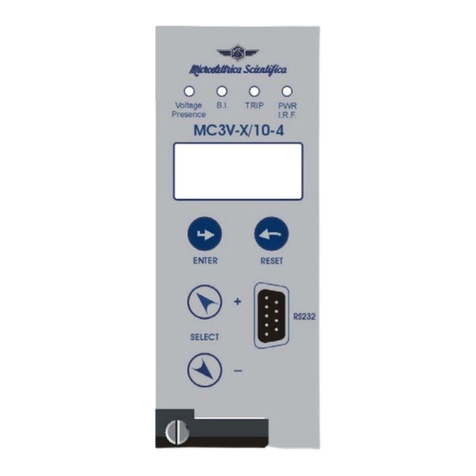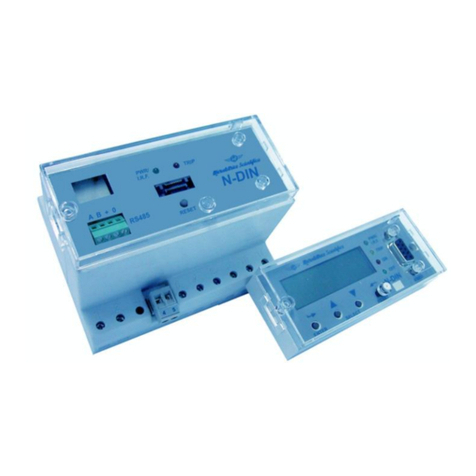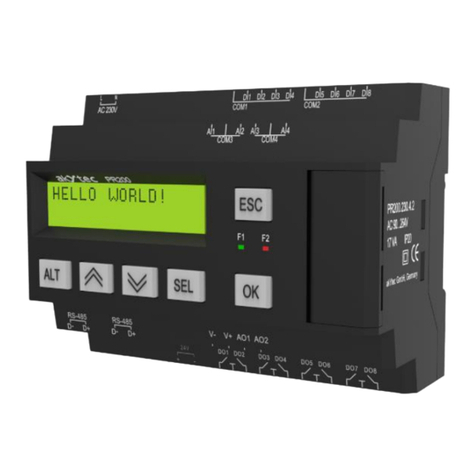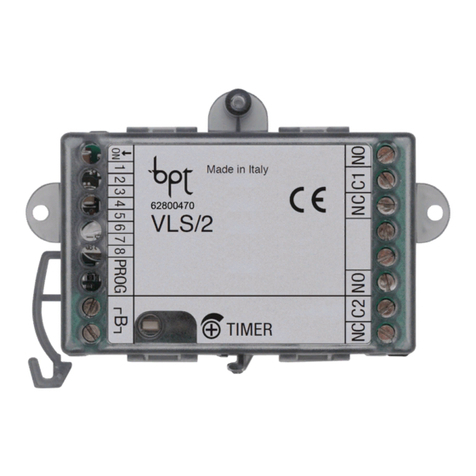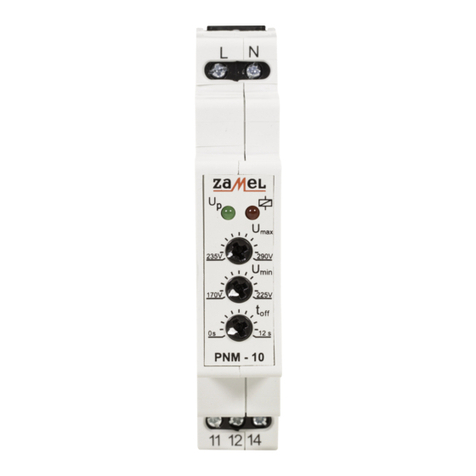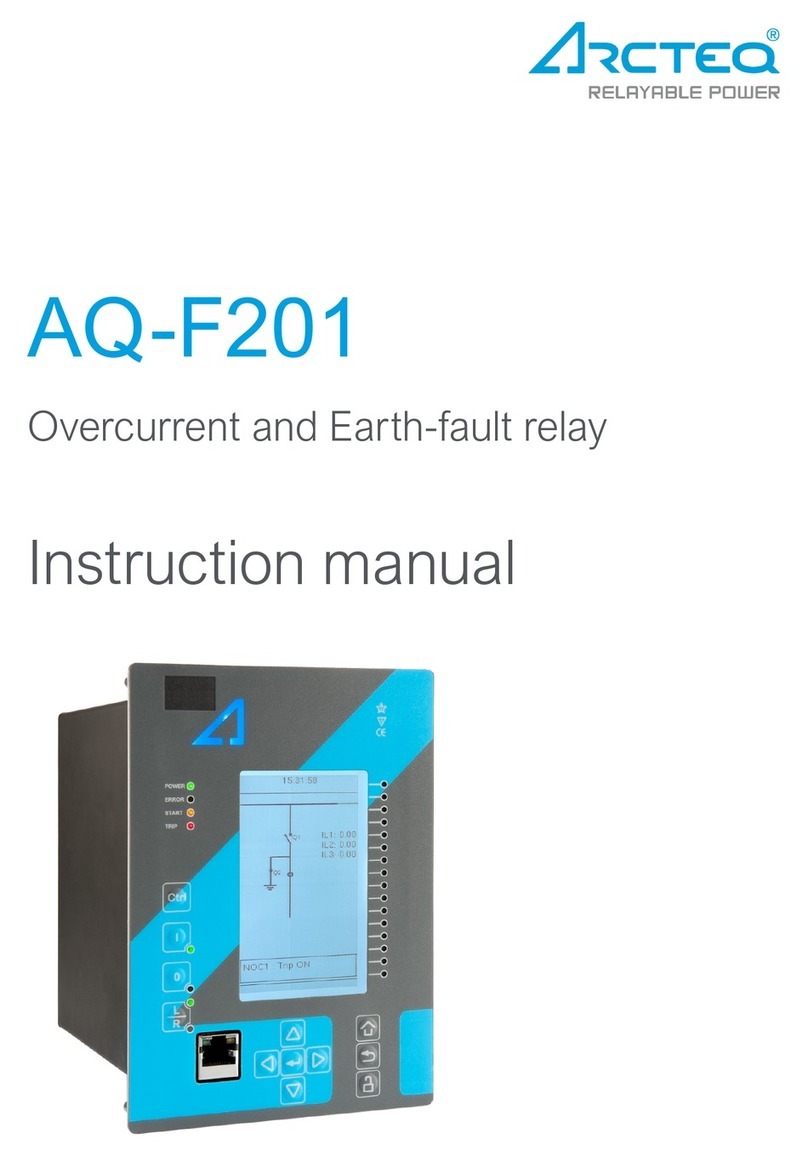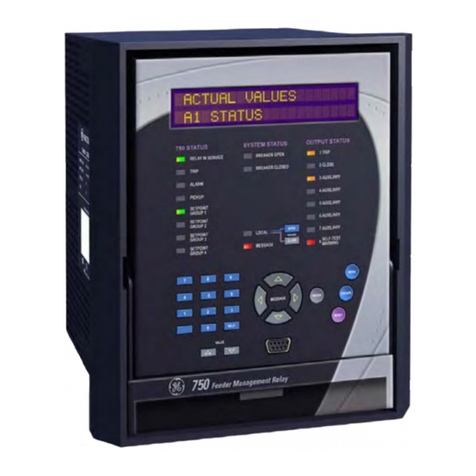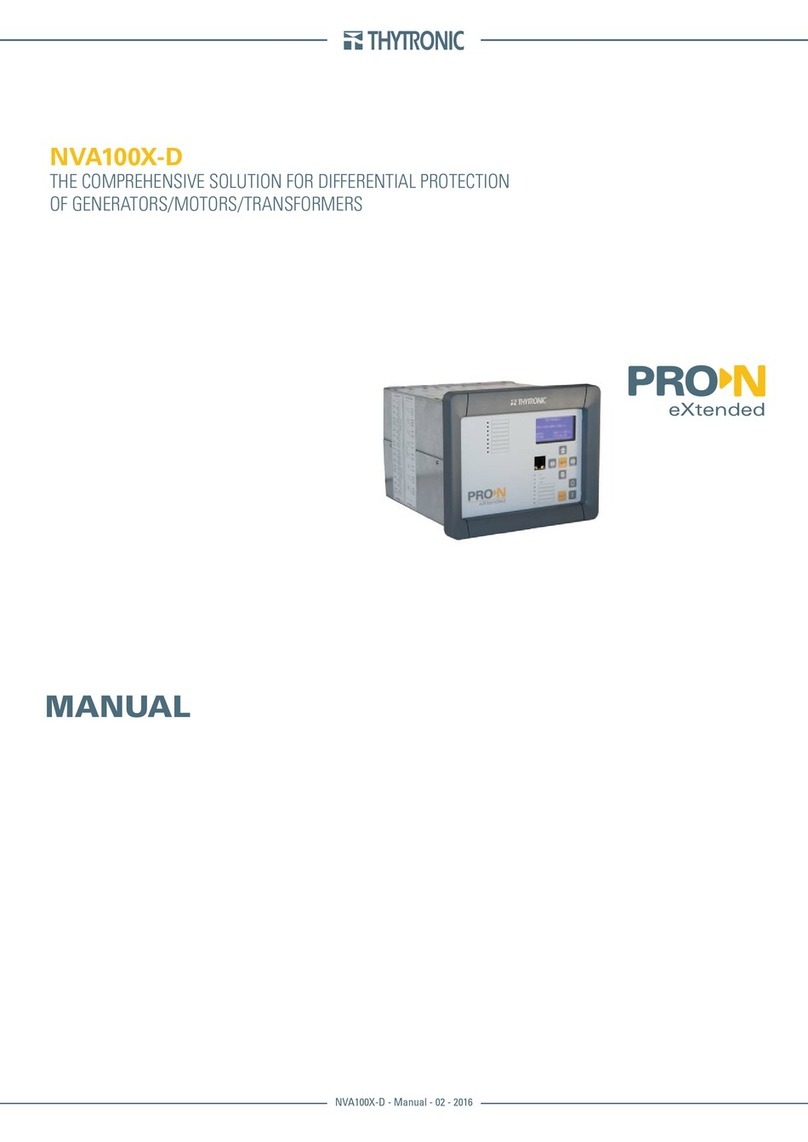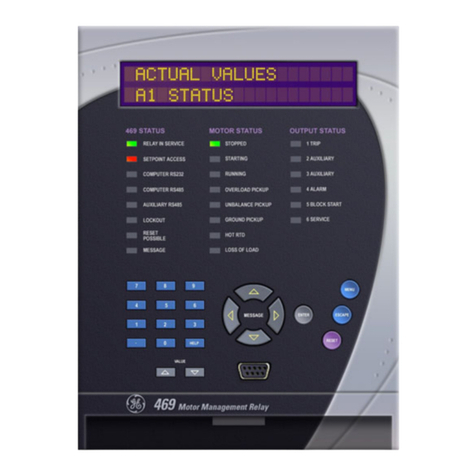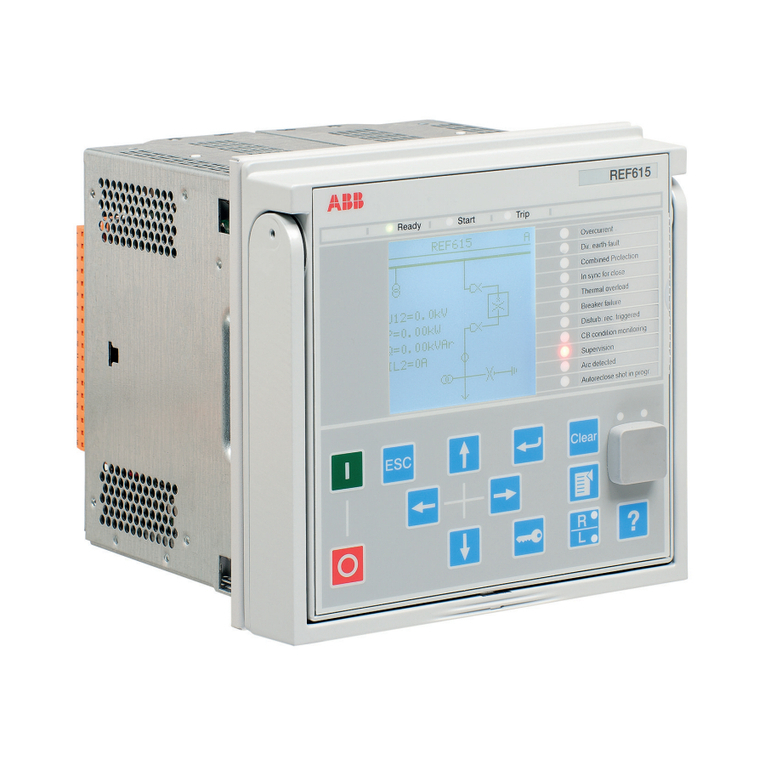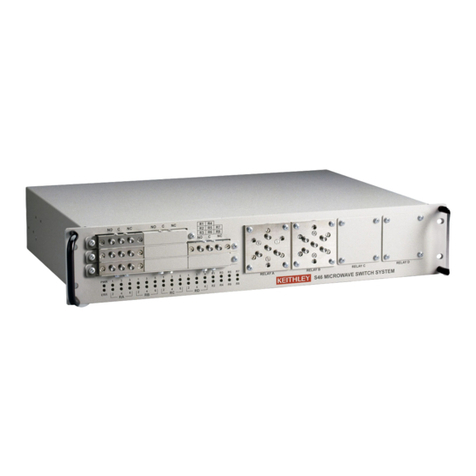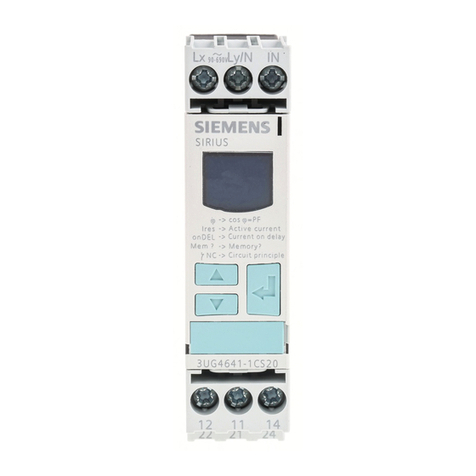MICROENER M-LIB3 User manual

M-LIB3
Doc. N° MO-0082-ING
Rev. 1
Pag. 21 of 35
Copyright 2010 - Microener
6 M-LID3
DIGITAL
LOW IMPEDANCE
DIFFERENTIAL
PROTECTION RELAY
TYPE
M-LID3
LOW IMPEDANCE
BIASED DIFFERENTIAL
RELAY TYPE
M-LID3
ENTER/RESET
MODE
SELECT
+
-
PROG.
dB>
PROG/
I.R.F.
MICROELETTRICA SCIENTIFICA
MILANO ITALY
BLOCK
INPUT
dA>
dC>
dsv
REMOTE
TRIGGER
TIME
SYNC.

M-LIB3
Doc. N° MO-0082-ING
Rev. 1
Pag. 22 of 35
Copyright 2010 - Microener
6.1 GENERAL CHARACTERISTIC
Currents from the CTs of the Feeders connected to each protected zone are conveyed to a wiring bus
(one for each phase) that drives the positive and negative halfwave of the current on two different wires.
The wiring bus also carrys the signal from the CT’s saturation detectors.
One M-LID3 differential relay is connected to the wiring bus of its protected zone and from the wiring bus of
each phase it can measure :
The bias current IRproportional to the arithmetic summation of all the incoming and outcoming currents
of the feeder connected to the protected busbar zone.
The differential current Idproportional to the vector summation of all the currents of the zone.
The CTs saturation detectors shunt the measurement of Idduring saturation due to faults external to the
protected zone.
The Idmeasuring circuits are transformer isolated whereas the IRmeasuring circuits are optoisolated.
6.2 POWER SUPPLY
The auxiliary power is supplied by a built-in interchangeable module fully isolated and self
protected. Two options are available :
24V(-20%) / 110V(+15%) a.c. 80V(-20%) / 220V(+15%) a.c.
a) - b) -
24V(-20%) / 125V(+20%) d.c. 90V(-20%) / 250V(+20%) d.c.
Before energising the unit check that supply voltage is within the allowed limits.
6.3 MEASUREMENTS ACQUISITION AND OPERATION PRINCIPLE
For enhanced reliability the A/D converters and the signal measuring circuits are totally duplicated.
Furthermore all the signal processing elements are duplicated.
It means that any step of operation takes place only if two elements produce the same output.
The basic detection elements are :
The CTs Circuit Supervision element which compares the actual differential current Idwith the CTs
Circuit Supervision Level ISV :
operation when Id> [ISV]
The zone differential current element which compares the actual differential current Idwith the set
minimum pick-up level IdS :
operation when Id> [IdS]
The zone Biased Differential Current element which compares the actual differential current with the
actual trip level “IS” calculated in function of the zone through current IRand the bias coefficient R
operation when Id> ([IdS] + R IR)

M-LIB3
Doc. N° MO-0082-ING
Rev. 1
Pag. 23 of 35
Copyright 2010 - Microener
The signal from CT saturation detectors shunts the measurement for a time proportional to the
saturation. This strongly contributes to stability during through faults while maintaining high sensitivity
to internal faults.
The operation logic in each phase is functionally explained in the following diagram.
Operation of the main zone relay takes place if the following conditions exists :
Id > [IdS]
Id> ISIS= [IdS] + [R] IR
Operation of the Circuit Breakers connected to each busbar zone takes place if the zone relay and the
check zone relay both operate.
6.4 OPERATION OF THE BIASED DIFFERENTIAL ELEMENTS
In each phase the relay measures the differential current existing in the busbar zone (vector
summation of all the incoming and outgoing currents).
When no fault inside the zone is experienced should be Id= 0.
Due to differences among the CTs and mostly to CT saturation when faults outside the zone make large
through current flow, the actual summation of the zone currents is not zero.
The larger is the through current the larger is the resultant Id.
The bias effect is than proportional to the through current
The operation is based on the following programmable variables :
Minimum operation setting threshold : IdS = (0.2-2)In
Per Unit bias coefficient in the area [1IR]<IR<[2IR] : 1R = (0.4-1)pU
Action starting point of 1R : 1IR= (0.5-2)In
Per Unit bias coefficient in the area IR>[IR2] : 2R =(0.4-1)pU
Action starting point of 2R : 2IR= (3-8)In
id II
i
RII
A/D
1
A/D
2
Id1
Id2
2IR
1IR
IR
Id
I >[I ]d1 SV
I >[I ]d2 SV
XOR
OR
x 0.9
x 0.9
ENABLE
ENABLE
I >[I ]d1 dS
I >[I ]d2 dS
I >Id1 S
I >Id2 S
XOR
OR
&
trf
tsv
ZONE
TRIP
RELAY
FAULT
CTs
FAULT
&
Id>Is
Id>[Ids]
&

M-LIB3
Doc. N° MO-0082-ING
Rev. 1
Pag. 24 of 35
Copyright 2010 - Microener
To compensate the differential current produced by CT’s error or saturation, the actual minimum
operation level ISis dynamically adjusted in function of the actual through current IRaccording to the set
coefficient [1R], [2R]
IR< [1IR] : IS= IdS
[1IR] < IR < [2IR] : IS= IdS + 1R(IR-[1IR])
IR> [2IR] : IS= IdS + 1R([2IR]-[1IR]) + 2R(IR-[2IR])
BIAS SATURATION : IS= 10 In for any IR
Is/In
I /InR
[2I ]R
[1I ]R
1R
2R
I /Inds IdS
IR
IdS R
dS
I
I
R

M-LIB3
Doc. N° MO-0082-ING
Rev. 1
Pag. 25 of 35
Copyright 2010 - Microener
6.5 CONTROLS AND MEASUREMENTS
Five key buttons allow for local management of all relay's functions.
A 8-digit high brightness alphanumerical display shows the relevant readings (xxxxxxxx)
(see synoptic table fig.1)
FIG.1
MEASURES
MAX VAL
LastTr-X
TRIP NUM
ACT MEAS
Actual measuremant values
Max. values measured
Recording of last five events
N° of tripping for each function
Measurements
display
SET DISP
SETTINGS
FRELAY
Display of setting
Display of configuration of output relay
Setting Program
display
PROGR
SETTINGS
FRELAY
Setting of parameters
Configuration of output relays
Set Programming
PROG
TEST PRG
W/O TRIP
WithTRIP
Functional Test
Test with operation of signals and output relays
Test with operation of signals only
Test activation
by the key ENTER
Paramater scanning
by the key
SELECT
Parameter modification
by the key “+” “-”
Set validation
by the key ENTER
Scanning of
the menus by
the key
“+” “-”
MODE
SELECT
ENTER
+ -
(*) Enabled only if input current is zero
(*)
(*)
ENTER/RESET
MODE
SELECT
+
-
PROG.
The SELECT button chooses
which category of values within the
chosen mode to display
Pressing this button progressively
selects between
Measurements Display,
Setting Display, Programming,
and Test modes
When in Program mode, this
button stores the newly selected
value. If not in Program mode and
the relay has tripped, this button
resets the relay and all output
contacts. If not tripped, this button
restores the default display.
The + and - buttons are used to
select the actual measurement or
display desired when in
Measurements Display or Settings
Display modes. When in Program
mode, these buttons increase or
decrease the value of the
displayed setting.
When in Program mode, and when
all input currents are zero,
pressing this recessed button
places the relay into active
programming mode, allowing any
or all of the relay’s settings to be
altered.

M-LIB3
Doc. N° MO-0082-ING
Rev. 1
Pag. 26 of 35
Copyright 2010 - Microener
6.6 SIGNALIZATIONS
Eight signal leds (normally off) are provided:
a)
Red LED
dA>
Flashing when IdA > [Ids].
Illuminated on tripping of the biased differential element : IdA > IS
b)
Red LED
dB>
Flashing when IdB > [Ids].
Illuminated on tripping of the biased differential element : IdB > IS
c)
Red LED
dC
Flashing when IdC > [Ids].
Illuminated on tripping of the biased differential element : IdC > IS
d)
Red LED
dvs
Flashing during supervision time delay
Illuminated on tripping of the CT’s Supervision element.
e)
Yellow LED
PROG/
I.R.F.
Flashing during the programming of the parameters or in case of
Internal Relay Fault.
f)
Red LED
Remote
Trigger
Illuminated when the oscillography trigger input is activated
g)
Red LED
Time
Sync.
Illuminated when synchronization input is active
h)
Yellow LED
BLOCK
INPUT
Flashing when digital input B1 is activated
The reset of the leds takes place as follows
From flashing to off, automatically when the lit-on cause disappears.
From ON to OFF, by "ENTER/RESET" push button only if the tripping cause has disappeared.
In case of auxiliary power supply failure the status of the leds is recorded and reproduced when power
supply is restored.
dB>
PROG/
I.R.F.
BLOCK
INPUT
a
b
c
d
e
f
g
h
REMOTE
TRIGGER
TIME
SYNC.
dvs
dC>
dA>

M-LIB3
Doc. N° MO-0082-ING
Rev. 1
Pag. 27 of 35
Copyright 2010 - Microener
6.7 OUTPUT RELAYS
Five output relays are available (R1, R2, R3, R4, R5)
The relays R1,R2,R3,R4 are normally deenergized (energized on trip): these output relays are user
programmable and any of they can be associated to any of the M-LID3's functions.
Any relay associated to of any function picks-up as soon as the measured input value gets into the
operation zone.
The reset after tripping of the relays (when tripping cause has been cleared) can be programmed as
Manual or Automatic (Variable FRes=Man/Aut).
FRes = Aut : Automatic Reset as soon as pick-up cause has been cleared.
FRes = Man : Reset by ENT/RESET KEY on relay’s front or via serial port
The relay R5, normally energized, is not programmable and is deenergized on:
Internal fault.
Power supply failure.
During the programming.
6.8 SERIAL COMMUNICATION (Optional: see relevant instruction manual)
The relays fitted with the serial communication option can be connected via a cable bus or
(with proper adapters) a fiber optic bus for interfacing with a Personal Computer
Via the communication bus all settings and commands available from relay's keyboard can be operated
from the computer and viceversa all information available at relay's level can be received at computer's
level. The transmission standard is RS485 (converter 485/232 available) with ModBus/Jbus protocol.
Each relay is identified by its programmable address code (NodeAd) and can be called from the P.C.
fitted with a WINDOWS (95/98 or later) program driven by an application program supplied by
Microelettrica Scientifica or made by the user.
6.9 OSCILLOGRAPHY RECORDS
The relay continuously records in a buffer the samples of the three phase differential currents.
The buffer contains samples for approximately 16 periods.
Recording is stopped approximately 8 periods after a trigger signal is received and the content of the
buffer is stored into memory.
Therefore in the memory are stored the wave forms for 8 cycles before and 8 cycles after the trigger
instant.
The trigger can be operated either internally on tripping of any function programmed IdS, IS, or externally
by activation of the REMOTE TRIGGER digital input.
Selection between the two modes is made by programming the variable TRG = EXT, IdS, IS,
The last two oscillography records are stored; a third record replaces the first of the two records.
6.10 DIGITAL INPUTS
Three inputs active when the relevant terminals are shorted are provided:
TS
terminals
1 - 2
:
For time synchronization
BI
terminals
1 - 3
:
For trip lock-out
RT
terminals
1 - 14
:
External trigger for oscillography records

M-LIB3
Doc. N° MO-0082-ING
Rev. 1
Pag. 28 of 35
Copyright 2010 - Microener
6.11 TEST
Besides the normal "WATCHDOG" and "POWERFAIL" functions, a comprehensive program of self-test
and self-diagnostic provides :
Diagnostic and functional test with checking of program routines and memory's content, run every
time the aux. power is switched-on: the display shows the type of relay and its version number and
then switches over to the default display.
Dynamic functional test run during normal operation every 10 minutes.
Complete test activated by the keyboard or via the communication bus either with or without tripping
of the output relays.
6.12 KEYBOARD AND DISPLAY OPERATION
All controls can be operated from relay's front or via serial communication bus.
The keyboard includes five hand operable buttons (MODE) - (SELECT) - (+) - (-) - (ENTER/RESET)
plus one indirect operable key (PROG) (see synoptic table a fig.1):
a)
-
White key
MODE
:
when operated it enters one of the following operation modes
indicated on the display :
MEASURES
=
Reading of all the parameters measured and of those recorded
in the memory
SET DISP
=
Reading of the settings and of the configuration of the output
relays as programmed.
PROG
=
Access to the programming of the settings and of the
configuration of output relays
TEST PROG
=
Access to the manual test routines.
b)
-
Green key
SELECT
:
When operated it selects one of the menus available in the
actual operation MODE
c)
-
Red key
“ + ”AND “ - “
:
When operated they allow to scroll the different information
available in the menu entered by the key SELECT and to
increase-decrease the settings.
d)
-
Yellow key
ENTER/RESET
:
It allows:
- the validation of the programmed setting
- the actuation of test programs
- the reset of the default display indication
- the reset of signal Leds.
e)
-
Indirect key
:
Enables access to the programming.
ENTER/RESET
MODE
SELECT
+
-
PROG.

M-LIB3
Doc. N° MO-0082-ING
Rev. 1
Pag. 29 of 35
Copyright 2010 - Microener
6.13 READING OF MEASUREMENTS AND RECORDED PARAMETERS
Enter the MODE "MEASURE", SELECT the menus "ACT.MEAS"-"MAX VAL"-"LASTTRIP"-
"TRIP NUM", scroll available information by key "+" or "-" .
6.13.1 ACT.MEAS
Actual values as measured during the normal operation. The values displayed are continuously
updated.
Display
Description
xxxxxxx
Current date in the DDMMMYY format.
xx:xx:xx
Current time in the HH:MM:SS format.
dAxx.xxn
R.M.S. value of differential current of phase A : (0-99.99) per unit of rated phase input current
dBxx.xxn
As above phase B
dCxx.xxn
As above phase C
IR xx.xn
Through current (0-99.9) per unit of the rated input current
IS xx.xn
Actual calculated differential trip level
6.13.2 MAX VAL
Highest values recorded from Breaker closing, (updated any time the breaker closes).
Display
Description
dAxx.xxn
Differential current of phase A : (0-99.99) per unit of rated phase input current
dBxx.xxn
As above phase B
dCxx.xxn
As above phase C
IR xx.xn
Through current (0-99.9) per unit of the rated input current
6.13.3 LASTTRIP
Display of the function which caused the tripping of the relay plus values of the parameters at the
moment of tripping. The memory buffer is refreshed at each new relay tripping.
Display
Description
LastTr-x
Indication of the recorded event (x= 0 to 4)
Example: Last event (LastTr -0)
Last but one event (LastTr-1) etc...
xxxxxxx
Current date in the DDMMMYY format.
xx:xx:xx
Current time in the HH:MM:SS format.
Cau:xxxx
Function which produced the event being displayed: dA>, dB>, dC>, Isv
dAxx.xxn
Differential current phase A
dBxx.xxn
Differential current phase B
dCxx.xxn
Differential current phase C
IR xx.xn
Through current (0-99.9) per unit of the rated input current
6.13.4 TRIP NUM
Counters of the number of operations for each of the relay’s function.
The memory is non-volatile and can be cancelled only with a secret procedure.
Display
Description
dA> xxxx
Differential element phase A
dB> xxxx
Differential element phase B
dC> xxxx
Differential element phase C
Isv xxxx
C.Ts. Circuit Supervision

M-LIB3
Doc. N° MO-0082-ING
Rev. 1
Pag. 30 of 35
Copyright 2010 - Microener
6.14 READING OF PROGRAMMED SETTINGS AND RELAY'S CONFIGURATION
Enter the mode "SET DISP", select the menu "SETTINGS" or "F
RELAY", scroll information available
in the menu by keys "+" or "-".
SETTINGS= values of relay's operation parameters as programmed
F
RELAY= output relays associated to the different functions as programmed.
6.15 PROGRAMMING
The relay is supplied with the standard default programming used for factory test. [ Values here below
reported ( ----- ) ].
All parameters can be modified as needed in the mode PROG and displayed in the mode SET DISP
Programming is enabled only if no input current is detected (main circuit breakers open).
As soon as programming is enabled, the Led PRG/IRF flashes and the reclosing lock-out relay R5 is
deenergized. Enter MODE "PROG" and SELECT either "SETTINGS" for programming of parameters
or "FRELAY" for programming of output relays configuration; enable programming by the indirect
operation key PROG.
The key SELECT now scrolls the available parameters. By the key (+) , (-) the displayed values can be
modified; to speed up parameter's variation press the key SELECT while "+" or "-" are pressed.
Press key "ENTER/RESET" to validate the set values.
6.15.1 PROGRAMMING OF FUNCTIONS SETTINGS
Mode PROG menu SETTINGS. (Production standard settings here under shown).
Display
Description
Setting Range
Step
Units
xxxxxxx
Current date
DDMMMYY
-
-
xx:xx:xx
Current time
HH:MM:SS
-
-
Fn 50 Hz
System frequency
50 - 60
10
Hz
Ids 0.2 In
Basic minimum pick-up level of differential element
0.2 –2 –Dis
0.01
In
trf 1 s
Trip time delay of the Relay’s Internal Fault Detector
0.1 –9.9
0.1
s
BI OFF
Blocking Input enable
OFF –ON
-
-
1R 0.5 pU
Bias coefficient in the zone [1IR] <IR< [2IR]
0.4 –1
0.01
pU
1IR 1In
Action starting level for 1R
0.5 –2.0
0.1
In
2R 1.0 pU
Bias coefficient in the zone IR> [2IR]
0.4 –1.00
0.01
pU
2IR 6In
Action starting level for 2R
3 –8
0.1
In
Isv 0.2 In
Minimum pick-up level of CT supervision element
0.1 –1 - Dis
0.01
In
tsv 1 s
Time delay of the C.T Supervision element
0.1 –9.9
0.1
s
TRG: Ext
Trigger for oscillography records is Internal or External
(via digital input B3)
Ext - Ids
Is –Isv
-
-
Tsyn Dis m
Synchronization time internal
5-10-15
30-60-Dis
-
-
NodAd 1
Identification number for connection on serial communication bus
1 - 250
1
-
The setting Dis indicates that the function is disactivated.
In 500 Ap
In is the unit of measure,
0.2 is the
setting default
Ids is the name
of the variable

M-LIB3
Doc. N° MO-0082-ING
Rev. 1
Pag. 31 of 35
Copyright 2010 - Microener

M-LIB3
Doc. N° MO-0082-ING
Rev. 1
Pag. 32 of 35
Copyright 2010 - Microener
6.15.2 PROGRAMMING THE CONFIGURATION OF OUTPUT RELAYS
Mode PROG menu FRELAY (Production standard settings here under shown).
The key "+" operates as cursor; it moves through the numbers corresponding to the four programmable
relays in the sequence 1,2,3,4,(1= relay R1, etc.) and makes start flashing the information actually
present in the digit. The information present in the digit can be either the number of the relay (if this was
already associated to the function actually on programming) or a dot (-) if the relay was not yet
addressed.
The key "-" changes the existing status from the dot to the relay number or viceversa.
After having programmed all the four relay, press “ ENTER “ to validate the programmed
configuration.
Display
Description
Is 1---
Bias Differential element operates relay R1 eventually plus R2, R3, R4 as programmed
(one or more)
Ids -2--
Un-biased differential element operates relay R2, R3, R4 as programmed
Isv --3-
Time delayed CT supervision element operates relay R2, R3, R4 as programmed
FRes: Aut.
Reset of output relays after tripping is:
Aut. = Automatic Man. = Manually key Enter /Reset or via serial bus
d> -2 - 4
This dash means
that output relay
number 1 is not
assigned to this
element
This is the name of
protective element
The number 2
means that
output relay 2 will
operate when
this element trips
This dash means
that output relay
number 3 is not
assigned to this
element
The number 4 means
that output relay 4 will
operate when this
element trips

M-LIB3
Doc. N° MO-0082-ING
Rev. 1
Pag. 33 of 35
Copyright 2010 - Microener
6.16 MANUAL AND AUTOMATIC TEST OPERATION
6.16.1 Mode "TESTPROG" subprogram “W/O TRIP"
Operation of the yellow key activates a complete test of the electronics and the process routines.
All the leds are lit-on and the display shows (TEST RUN). If the test routine is successfully
completed the display switches-over to the default reading (dAxx.xxn). If an internal fault is
detected, the display shows the fault identification code and the relay R5 is deenergized. This test
can be carried-out even during the operation of the relay without affecting the relay tripping in
case a fault takes place during the test itself.
6.16.2 Mode "TESTPROG" subprogram "WithTRIP"
Access to this program is enabled only if the current detected is zero (breaker open).
Pressing the yellow key the display shows "TEST RUN?". A second operation of the yellow key
starts a complete test which also includes the activation of all the output relays. The display
shows
(TEST RUN) with the same procedure as for the test with W/O TRIP. During the normal operation
the relay continuously operates an auto test procedure. If any internal fault is detected during the
auto test, the relay R5 is deenergized, the relevant led is activated and the fault code is
displayed. If at the next automatic test no internal fault is detected the display and R5 reset.
Further operation of key SELECT instead of the TEST programs gives the indication of the version
and production date of the firmware.
WARNING
Running the WithTRIP test will operate all of the output relays. Care must be taken to ensure that no
unexpected or harmful equipment operations will occur as a result of running this test.
It is generally recommended that this test be run only in a bench test environment or after all dangerous
output connections are removed.
6.17 MAINTENANCE
No maintenance is required. Periodically a functional check-out can be made with the test procedures
described under MANUAL TEST chapter. In case of malfunctioning please contact
Microelettrica Scientifica Service or the local Authorised Dealer mentioning the relay's Serial No reported
in the label on relays enclosure.
WARNING
In case of Internal Relay Fault detection, proceed as here-below indicated :
If the error message displayed is one of the following “DSP Err”, “ALU Err” ,”KBD Err” ,”ADC Err”,
switch off power supply and switch-on again. If the message does not disappear send the relay to
Microelettrica Scientifica (or its local dealer) for repair.
If the error message displayed is “E2P Err”, try to program any parameter and then run “W/OTRIP”.
If message disappear please check all the parameters.
If message remains send the relay to Microelettrica Scientifica (or its local dealer) for repair.

M-LIB3
Doc. N° MO-0082-ING
Rev. 1
Pag. 34 of 35
Copyright 2010 - Microener
6.18 CLOCK AND CALENDAR
The unit features a built in clock calendar with Years, Months, Days, Hours, Minutes, Seconds,
Tenths of seconds and Hundredths of seconds.
6.18.1 Clock synchronization.
The clock can be synchronized via a digital input (terminals 1 –14) or the serial communication
interface. The following synchronization periods can be set: 5, 10, 15, 30, 60 minutes.
Synchronization can also be disabled, in which case the only way to modify the current date and
time is via the front panel keyboard (SETTINGS menu) or the serial communication interface.
In case synchronization is enabled, the unit expects to receive a sync signal at the beginning of
every hour and once every Tsyn minutes. When a sync signal is received, the clock is
automatically set to the nearest expected synchronization time.
For example: if Tsyn is 10min and a sync signal is received at 20:03:10 January the 10th, 98, then
the clock is set to 20:00:00 January the 10th, 1998.
On the other hand, if the same sync signal were received at 20:06:34, the clock would be set to
20:10:00, January the 10th 98.
Note that if a sync signal is received exactly in the middle of a Tsyn period, the clock is set to the
previous expected synchronization time.
6.18.2 Date and time setting.
When the PROG/SETTINGS menu is entered, the current date is displayed with one of the
groups of digits (YY, MMM or DD) blinking.
The DOWN key operates as a cursor. It moves through the groups of digits in the sequence
YY => MMM => DD => YY => …
The UP key allows the user to modify the currently blinking group of digits.
If the ENTER button is pressed the currently displayed date is captured.
On the other hand pressing the SELECT button leaves the current date unchanged and scrolls
the SETTINGS menu. Current time can now be modified using the same procedure described
above. If synchronization is enabled and the date (or time) is modified, the clock is stopped until
a sync signal is received (via digital input or the serial port). This allows the user to manually set
many units and have them to start their clocks in a synchronized fashion.
On the other hand if synchronization is disabled the clock is never stopped.
Note that the setting of a new time always clears 10ths and 100ths of sec.
6.18.3 Time resolution.
The clock has a 10ms resolution. This means that any event can be time-stamped with a 10ms
resolution, although the information concerning 10ths and 100ths of sec. can be accessed only
via the serial communication interface.
6.18.4 Operation during power off.
The unit has an on board Real Time Clock which maintains time information for at least 1 hour in
case of power supply failure.
6.18.5 Time tolerance.
During power on, time tolerance depends on the on board crystal (+/-50ppm typ, +/-100ppm max.
over full temperature range).
During power off, time tolerance depends on the RTC’s oscillator (+65 –270 ppm max over full
temperature range).

M-LIB3
Doc. N° MO-0082-ING
Rev. 1
Pag. 35 of 35
Copyright 2010 - Microener
6.19 WIRNG DIAGRAM M-LID3 (SCE1579)

M-LIB3
Doc. N° MO-0082-ING
Rev. 1
Pag. 36 of 35
Copyright 2010 - Microener
6.20 ELECTRICAL CHARACTERISTICS
REFERENCE STANDARDS IEC 60255 - EN50263 - CE Directive - EN/IEC61000 - IEEE C37
Dielectric test voltage
IEC 60255-5
2kV, 50/60Hz, 1 min.
Impulse test voltage
IEC 60255-5 : 5kV (c.m.), 2 kV (d.m.) - 1,2/50s
5kV (c.m.), 2kV (d.m.) –1,2/50s
Climatic tests
IEC 68-2 : 5kV (c.m.), 2 kV (d.m.) - 1,2/50s
CE EMC Compatibility (EN50081-2 - EN50082-2 - EN50263)
Electromagnetic emission
EN55022
Radiated electromagnetic field immunity test
IEC61000-4-3
level 3
80-1000MHz
10V/m
ENV50204
900MHz/200Hz
10V/m
Conducted disturbances immunity test
IEC61000-4-6
level 3
0.15-80MHz
10V/m
Electrostatic discharge test
IEC61000-4-2
level 4
6kV contact / 8kV air
Power frequency magnetic test
IEC61000-4-8
1000A/m
50/60Hz
Pulse magnetic field
IEC61000-4-9
1000A/m, 8/20s
Damped oscillatory magnetic field
IEC61000-4-10
100A/m, 0.1-1MHz
Electrical fast transient/burst
IEC61000-4-4
level 4
2kV, 5/50ns, 5kHz
HF disturbance test with damped oscillatory wave (1MHz
burst test)
IEC60255-22-1
class 3
400pps, 2,5kV (m.c.), 1kV (d.m.)
Oscillatory waves (Ring waves)
IEC61000-4-12
level 4
4kV(c.m.), 2kV(d.m.)
Surge immunity test
IEC61000-4-5
level 4
2kV(c.m.), 1kV(d.m.)
Voltage interruptions
IEC60255-4-11
200ms
Resistance to vibration and shocks
IEC60255-21-1 - IEC60255-21-2 –10-50Hz –1g
CHARACTERISTICS
Accuracy at reference value of influencing factors
2% Rated Input
for measure
2% +/- 10ms
for times
Average power supply consumption
8.5 VA
Output relays
rating 5 A; Vn = 380 V
A.C. resistive switching = 1100W (380V max)
make = 30 A (peak) 0,5 sec.
break = 0.3 A, 110 Vcc,
L/R = 40 ms (100.000 op.)
Operation ambient temperature
-10°C / +55°C
Storage temperature
-25°C / +70°C
Humidity
93% Without Condensing
Microelettrica Scientifica S.p.A. - 20089 Rozzano (MI) - Italy - Via Alberelle, 56/68
Tel. (##39) 02 575731 - Fax (##39) 02 57510940 - Telex 351265 MIELIT I
http://www.microelettrica.com e-mail : ute@microelettrica.com
The performances and the characteristics reported in this manual are not binding and can modified at any moment without notice
Table of contents
Other MICROENER Relay manuals

MICROENER
MICROENER IM3G-VX User manual
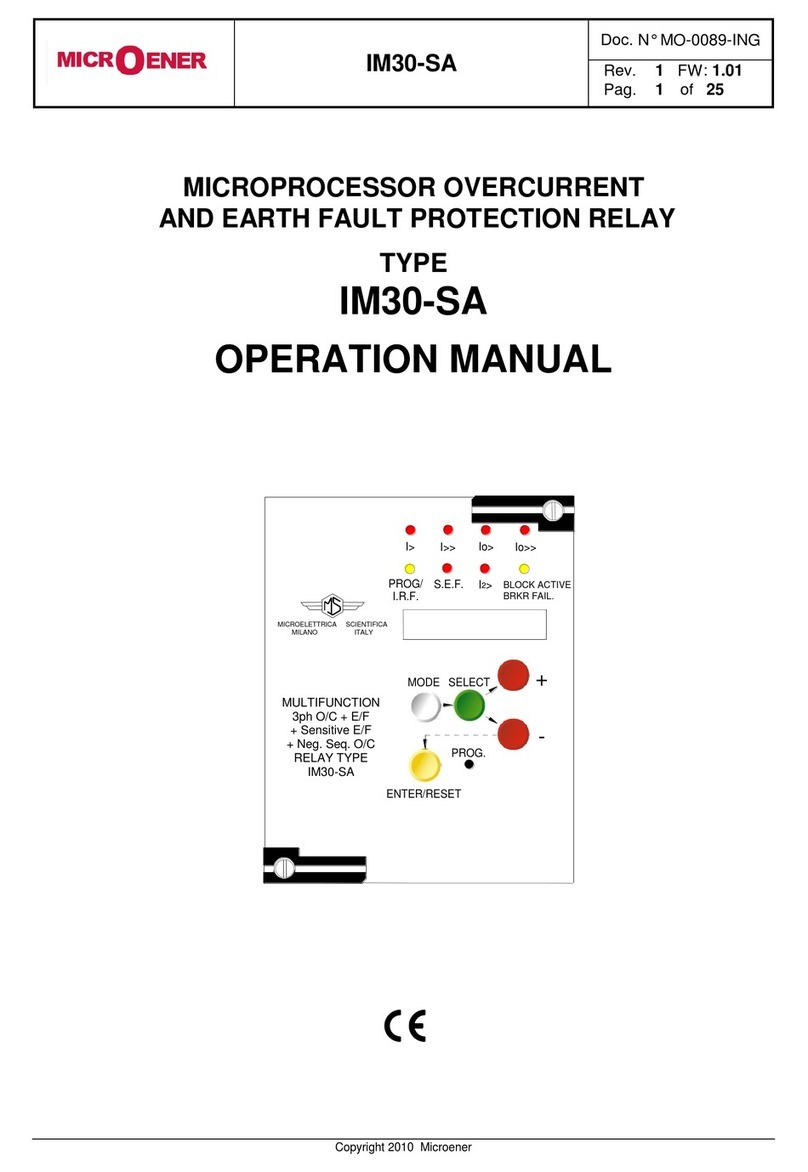
MICROENER
MICROENER IM30-SA User manual

MICROENER
MICROENER ELR-3B User manual
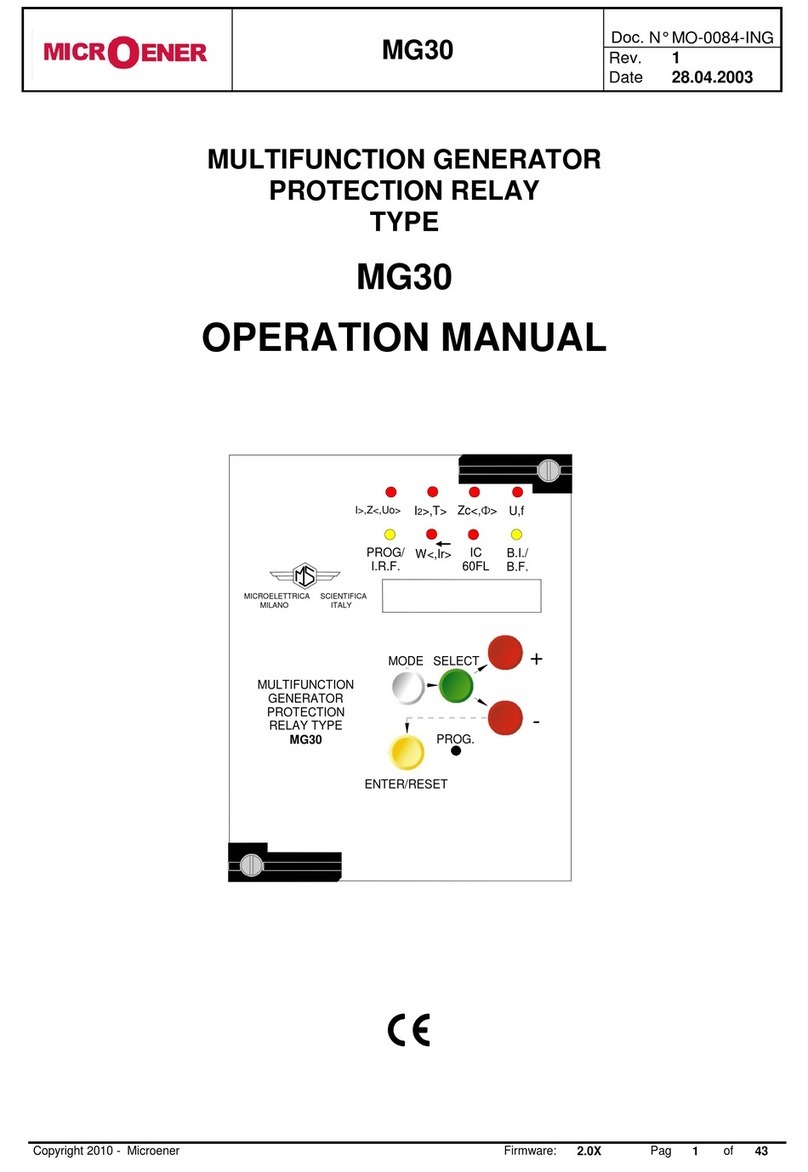
MICROENER
MICROENER MG30 User manual

MICROENER
MICROENER ULTRA Series User manual
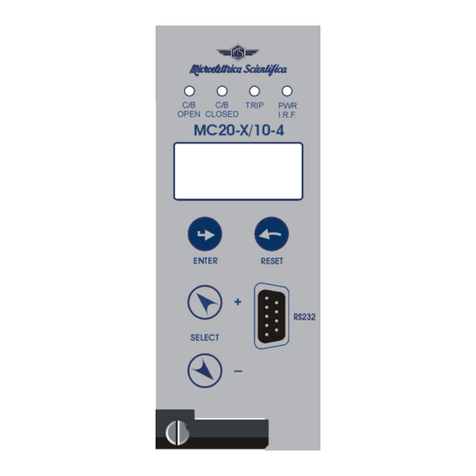
MICROENER
MICROENER MC20-X/10-4 User manual

MICROENER
MICROENER ELRC-1 User manual

MICROENER
MICROENER IM30-B00 User manual
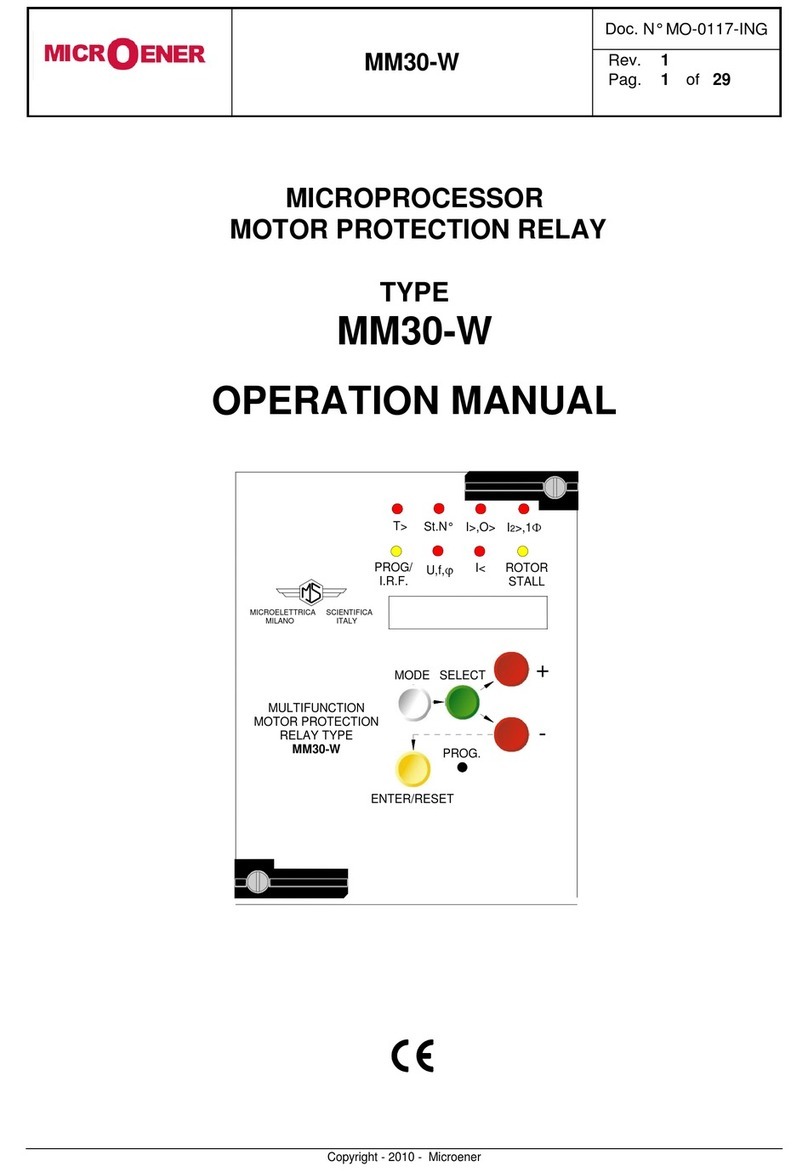
MICROENER
MICROENER MM30-W User manual
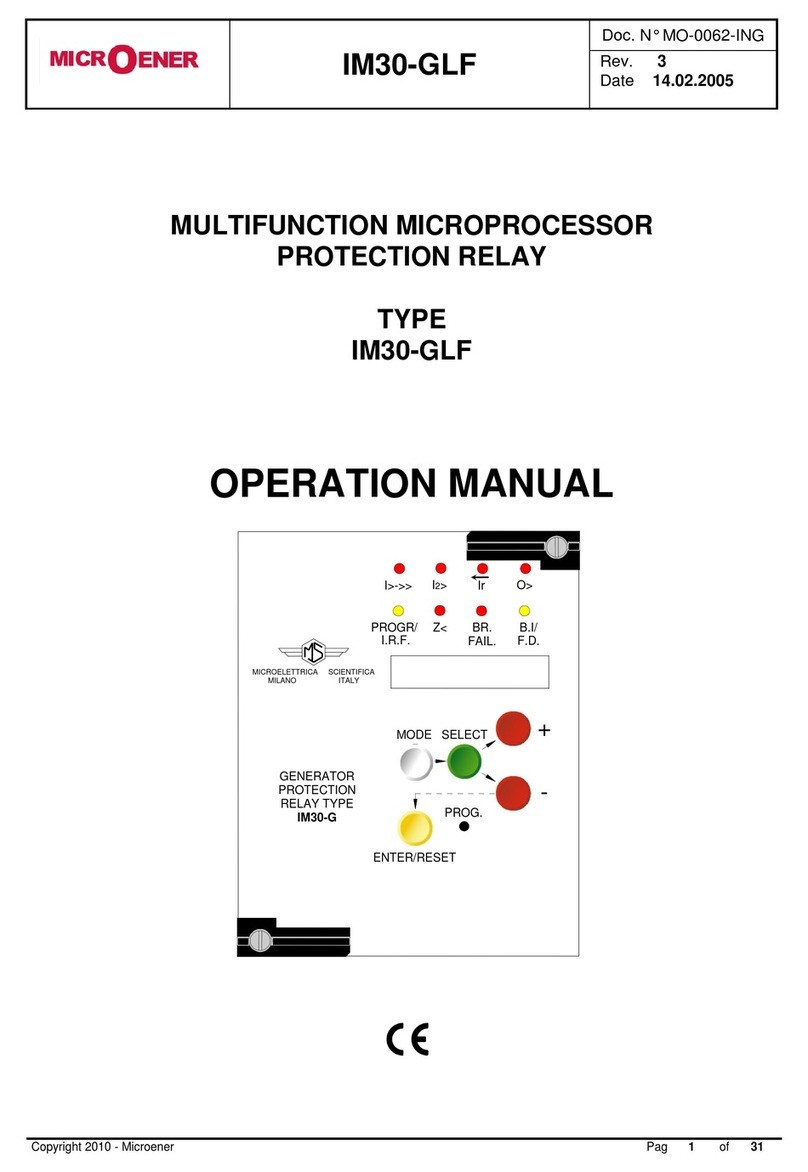
MICROENER
MICROENER IM30-GLF User manual
